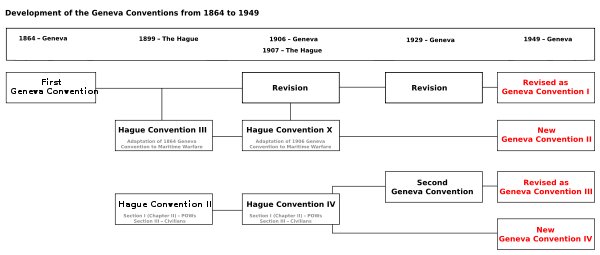Geneva Conventions

The Geneva Conventions consist of four treaties formulated in Geneva, Switzerland, that set the standards for international law for humanitarian concerns.
They chiefly concern the treatment of non-combatants and prisoners of war. They do not affect the use of weapons in war, which are covered by the Hague Conventions of 1899 and 1907 and the Geneva Protocol on the use of gas and biological weapons of 1925.
The Conventions were the results of efforts by Henry Dunant, who was motivated by the horrors of war he witnessed at the Battle of Solferino in 1859. In 1977 and 2005 three separate amendments were made part of the Geneva Conventions.
The adoption of the First Convention followed the foundation of the International Committee of the Red Cross in 1863. The text is given the title Resolutions of the Geneva International Conference, Geneva, 26–29 October 1863.
As of 2 August 2006,[1] when the Republic of Montenegro adopted the four conventions, they have been ratified by 194 countries.
The conventions and their agreements

Development of the Geneva Conventions from 1864 to 1949.
|
All conventions were revised and expanded in 1949.
- First Geneva Convention "for the Amelioration of the Condition of the Wounded and Sick in Armed Forces in the Field" (first adopted in 1864, last revision in 1949).
- Second Geneva Convention "for the Amelioration of the Condition of Wounded, Sick and Shipwrecked Members of Armed Forces at Sea" (first adopted in 1906).
- Third Geneva Convention "relative to the Treatment of Prisoners of War" (first adopted in 1929, last revision in 1949).
- Fourth Geneva Convention "relative to the Protection of Civilian Persons in Time of War" (first adopted in 1949, based on parts of the 1907 Hague Convention IV).
Protocols
In addition, there are three additional amendment protocols to the Geneva Conventions:
- Protocol I (1977): Protocol Additional to the Geneva Conventions of 12 August 1949, relating to the Protection of Victims of International Armed Conflicts. As of 12 January 2007, it had been ratified by 167 countries.
- Protocol II (1977): Protocol Additional to the Geneva Conventions of 12 August 1949, relating to the Protection of Victims of Non-International Armed Conflicts. As of 12 January 2007, it had been ratified by 163 countries.
- Protocol III (2005): Protocol Additional to the Geneva Conventions of 12 August 1949, relating to the Adoption of an Additional Distinctive Emblem. As of June 2007, it had been ratified by 17 countries and signed but not yet ratified by an additional 68 countries (see Red Crystal).
Revision and ratification
All four conventions were last revised and ratified in 1949, based on previous revisions and partly on some of the 1907 Hague Conventions; the whole set is referred to as the "Geneva Conventions of 1949" or simply the "Geneva Conventions". Later conferences have added provisions prohibiting certain methods of warfare and addressing issues of civil wars. Nearly all 200 countries of the world are "signatory" nations, in that they have ratified these conventions.
Clara Barton was instrumental in campaigning for the ratification of the First Geneva Convention by the United States; the U.S. signed in 1882. By the Fourth Geneva Convention, some 47 nations had ratified the agreements.
General Provisions of the First Three Common Articles
Each of the four conventions begins with three virtually identical articles.
Common Article 1
Article 1 reads: "The High Contracting Parties undertake to respect and to ensure respect for the present Convention in all circumstances."
Common Article 2
Article 2 specifies which parties are bound, and under what circumstances.
- That any armed conflict between two or more "High Contracting Parties" is covered;
- That it applies to occupations of a "High Contracting Party";
- That the relationship between the "High Contracting Parties" and a non-signatory, the party will remain bound until the non-signatory no longer acts under the strictures of the convention. "...Although one of the Powers in conflict may not be a party to the present Convention, the Powers who are parties thereto shall remain bound by it in their mutual relations. They shall furthermore be bound by the Convention in relation to the said Power, if the latter accepts and applies the provisions thereof."
Common Article 3
Article 3 has been called a "Convention in miniature." It is the only article of the Geneva Conventions that applies in non-international conflicts.[2]
It describes minimal protections which must be adhered to by all individuals within a signatory's territory during an armed conflict not of an international character (regardless of citizenship or lack thereof): Noncombatants, combatants who have laid down their arms, and combatants who are hors de combat (out of the fight) due to wounds, detention, or any other cause shall in all circumstances be treated humanely, including prohibition of outrages upon personal dignity, in particular humiliating and degrading treatment. The passing of sentences must also be pronounced by a regularly constituted court, affording all the judicial guarantees which are recognized as indispensable by civilized peoples. Article 3's protections exist even though no one is classified as a prisoner of war.
The article text for Article 3 of the Second Geneva Convention differs from the other three Conventions in that it adds "shipwrecked" to the "wounded and sick."
Article 3 also states that parties to the internal conflict should endeavour to bring into force, by means of special agreements, all or part of the other provisions of the Geneva Conventions.
See also
- Attacks on humanitarian workers
- Command responsibility
- Geneva Conference
- Hague Conventions (1899 and 1907)
- Human rights
- International Federation of Red Cross and Red Crescent Societies
- Laws of war
- Nuremberg Principles
- Protective sign
- Reprisals
- War crime
References
- ↑ "State Parties / Signatories: Geneva Conventions of 12 August 1949". International Humanitarian Law. International Committee of the Red Cross. Retrieved on 2007-01-22.
- ↑ Convention (III) relative to the Treatment of Prisoners of War – Commentary 12 August, 1949
External links
- Texts and commentaries of 1949 Conventions & Additional Protocols
- ICRC overview of the Geneva Conventions
- Reference Guide to the Geneva Conventions
- www.SupportGenevaConventions.info
|
|||||
|
|||||||||||||||||
|
||||||||||||||||||||||||||||||||||||||||||||||||||||||||||||||||||||||||||||||||